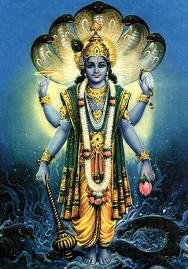 |
Essence Of
Bhavishya Purana
|
| 4 ‘Brahmachari Dharma’ (Duties of Bachelor Life) | |
Having taught the basics like ‘Suacha’ (Purity), ‘Aachaar’ (Tradition), and ‘Aachaman’, Sumantu Muni proceeded to describe the method of teaching ‘Vedadhyayana’ after a Vidyarthi got seated on a Kushagrass-made mat, wore a ‘Pavitra’ made again of Kusha, performed three ‘Pranayamas’or nasal exercises and recite ‘Omkara’- the representation of Three Vedas by the words viz. Akara, Uukara and Makara, or AUM. Further, Gayatri’s three ‘Padas’ or steps again taken from three Vedas were ‘Bhuh, Bhuvah and Swaha’, thus the integrated Tripada Gayatri viz. ‘Om Bhurbhuvah Swaha’. Those who recite Gayatri Mantra for three years continuously and formally in the prescribed manner with devotion would take the form of ‘Vayu’ (wind) and fly with speed on the sky and attain Brahma Tatwa. The single word OM is Parabrahma and ‘Pranayam’ is itself a unique Tapas (meditation).There is no better Mantra than Savitri or Gayatri. ‘Mouna’ or avoidance of talking except the Truth, Tapasya, ‘Havan’ or formal obeisance to Fire God, Daan, and Yagna-related tasks might have implications of practice / shortcomings and might even be subject to diminishing significance ; but recital of Omkar by way of ‘Japa Yagna’ of Pranava has an everlasting importance. While ‘Upanshu Japa’with only the movement of lips and tongue without making the least sound is far more effective than Japa otherwise, ‘Manasika Japa’ (only in mind) is stated to be more Superior to Upanshu Japa; this is as valuable as ‘Paka Yagna’comprising Pitru Karma, Havan and Bali Vaiswa Deva executed together in a formal manner and hence the utmost significance of Gayatri-Japa, which would be a must to Brahamanas! Recital of Gayatri Mantra at ‘Praathah Sandhya’ or before Sunrise is very significant and so is ‘Sayam Sandhya’ or before Sun set till the appearance of Stars on the Sky. Praatah Sandhya is better performed while standing so that the sins of the previous night are demolished and contrarily Gayatri Japa before Sun set is effected while seated; the Place for carrying the Gayatri Japa should be secluded in Privacy, an open space or lonely banks of a river or water bodies and without ‘Uccharana’ or vocal utterance. A Brahmachari is expected to stay at the residence of a Guru, without comforts but with bare necessities; for example he is to sleep on Earth; perform service to Guru / Parents; by absorbing the know-how or the awareness of contempory happenings without reactions as mere water drops on a lotus leaf! Besides one’s own Parents and his Guru (teacher), a Brahmachari has ten more Teachers viz. the son(s) of Guru, those who provide service, afford Knowledge and awareness of daily tasks, a Dharmic or a Virtuous; a Pavitra or a Puritan, ‘Vishwasi’or a Confidant worthy of Trust, ‘Shaktimaan’ or a source of Physical Strength, an ‘Udaar’ or liberal-minded, ‘Sadhu Swabhaav’ or Gentleman and a person of his own clan. A Brahmana is stated to have three births, one from his mother, another after wearing Yagnopaveet and the third after taking ‘diksha’ (observance) of Yagna. At the time of ‘Yagnopaveeta dharana’, mother is Gayatri and ‘Acharya’ or the intiator is father; the latter too is the Guru since the Brahmachari is bestowed with the authority of learning Vedas or ‘Vedadhyaayana’ and heretofore, boy was as good as others. But, since then or after Gayatri’s eligibility, a Brahmachari is bound by do’s and don’t’s as that eligibility entails duties such as wear Mekhala skin, Danda, ‘Vastras’ (clothes) as presribed and of course the Yagnopapeet. He should always maintain purity, discipline, restraint and dignity.He ought to be involved with the use of flowers, fruits, water, ‘Samidhas’ or dry wooden pieces for Agni Homams, mrittika or the water-bed earth, kusha grass, and such other material for the use of Sacred Tasks. Needless to emphasise that a Brahmachari should get rid of meat, madya (intoxicants), gandha or scented bases, flower garlands, violence, body-decoratives and scents, footwear, umbrellas, dance and music other than for religious purposes. The other ‘taboos’include ‘Asatya’ (utterances of lies), ‘Asteya’ (stealing), ‘Para Ninda’(criticism of others), company of women and involvement of ‘Arishad -vargas’ or the Six Enemies of human beings like desire, anger, greed, attachment, ego and envy. Whenever there is ‘Guru Ninda’ or criticism of Guru by others, be passive or aviod or close the ears. Thus a ‘Vidyardhi’ or a ‘Brahmachari’ has to euip and prepare himself in all the directions of moral life fully before he enters the hard core life of ‘Garhastya’ ahead! Before marriage, one has to realise that the two major corner-stones of wedded life are the kind of woman to marry and the utmost consideration of earning livelihood in a righteous way; mutual compatibility of man and woman by according equal status to each other is the key to perform ‘Dharmika Vidhis’ or the Duties of Virtue to accomplish the four essential ingredients of ideal human life viz. Dharma (Rectitude), Artha (Wealth / Well Being), Kama (Fulfillment of Desires) and Moksha (Salvation). | |
 Prev:‘Samskaras’ (Sacred Rites) Prev:‘Samskaras’ (Sacred Rites) | |
 Next:‘Samskaras’ (Sacred Rites)
Next:‘Samskaras’ (Sacred Rites)